Reproduction Vet. Anatomy and Physiology – Flashcards
Unlock all answers in this set
Unlock answersquestion
Deoxyribonucleic Acid (DNA)
answer
The genetic material of a living thing found in strands called chromatin within the nucleus of the cell
question
Chromatin
answer
A material that is composed of DNA and proteins and makes up chromosomes
question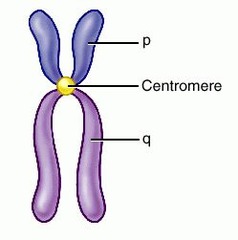
Chromosomes

answer
Threadlike accumulations of DNA in the nuclei of cells and contain genetic material of the cell
question
Diploid
answer
Expressed with the abbreviation 2n The chromosome number in all of an animal's cells, except for the reproductive cells
question
Sex Chromosomes
answer
determine the genetic sex of the individual (x,x or x,y)
question
Haploid
answer
The chromosome number in the reproductive cells, half of the diploid chromosome number
question
Mitosis
answer
Cell division of somatic cells for growth and to replace old or dead cells; the type of cell division that occurs in all body cells except the reproductive cells
question
Meiosis
answer
The reduction division that reproductive cells undergo during their development
question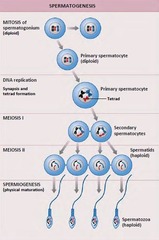
Spermatogenesis

answer
The production of spermatozoa, the male sex cells, in the seminiferous tubules of the testes Begins at the periphery of the seminiferous tubule with a cell called a primary spermatocyte
question
Epididymis
answer
stores sperm before ejaculation, The ribbon-like structure that lies along the surface of the testes, Actually one long convoluted tube that links the efferent ducts with the vas deferens
question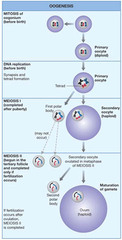
Oogenesis

answer
The production of female reproductive cells (ova) in the developing ovarian follicles At or soon after birth, a female has a fixed number of primary oocytes
question
Oogenesis pt 2
answer
from one primary oocyte, one mature ovum will result
question
Testes
answer
Male gonads, where spermatozoa are formed
question
Interstitial cells
answer
produce male sex hormones or androgens
question
testosterone
answer
responsible for the development of male secondary sex characteristics
question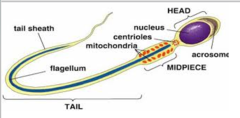
Spermatozoa head

answer
Contains the nucleus of the cell
question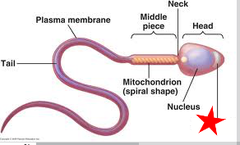
acrosome

answer
caps the head of the spermatozoa and contains digestive enzymes that are released once the spermatozoon is inside the female reproductive tract
question
Spermatozoa Midpiece
answer
The power plant of the cell that contains a large concentration of energy producing mitochondria arranged in a spiral pattern
question
Spermatozoa tail
answer
Contains muscle-like contractile fibrils that produce a whip-like movement of the tail and propel the cell forward once it is activated
question
Testes Development
answer
begin in the abdominal cavity near the kidneys, attached to the scrotum by a band of connective tissue called the gubernaculum
question
Testes Decent
answer
As the embryo grows, the gubernaculum remains fairly constant in length, this results in * gradually being pulled caudally and ventrally, are normally pulled down through the inguinal rings into the scrotum
question
Scrotum
answer
Sac of skin that houses the testes
question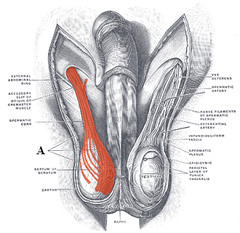
cremaster muscle

answer
passes down through the inguinal ring and attaches to the scrotum, in warm conditions, the muscle relaxes and the testes hang down away from the warm body, in cold conditions, the muscle pulls the testes up tight against the body to help warm them
question
Spermatic Cord
answer
Tube-like connective tissue structures that contain blood vessels, nerves, lymphatic vessels, and the vas deferens
question
pampiniform plexus
answer
an intricate meshwork of tiny veins derived from the testicular vein where blood is cooled in the testes
question
Vaginal tunic
answer
Surrounds the testes in the scrotum and in the spermatic cord
question
Visceral vaginal tunic (Proper vaginal tunic)
answer
The thin, inner connective tissue layer that is tightly adherent to the surface of the testes and the structures of the spermatic cord Derived from the visceral peritoneum
question
Parietal vaginal tunic (Common vaginal tunic)
answer
The thick outer connective tissue layer around the testis and spermatic cord Derived from parietal peritoneum
question
Tunica Albuginea
answer
A heavy, fibrous tissue capsule that protects and supports the soft contents of the testis Small partitions called septa, extend into the testis from the capsule
question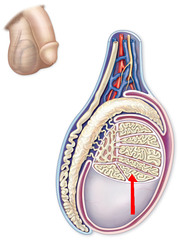
Seminiferous tubules

answer
Where spermatogenesis takes place
question
rete testis
answer
a complex system of ducts where the seminiferous tubules connect
question
interstitial cells
answer
produce androgens, the male sex hormones, under the influence of luteinizing hormone (LH) (also called Interstitial Cell-Stimulating Hormone (ICSH)) from the anterior pituitary gland
question
Sertoli cells
answer
Large nurse cells to which spermatids are attached during their development, help shield the developing spermatozoa from the body's immune system
question
Sertoli Cell Tumors
answer
Produce excess estrogen Causes: Feminization in the male dog Pendulous prepuce Enlarged mammary glands that may produce milk Penis and testes atrophy (shrink) May be attractive to male dogs as if he were in heat
question
Cryptorchidism
answer
undescended testicles, occurs most commonly in horses and pigs
question
Duct system
answer
When sperm are ready to leave the seminiferous tubules, they flow through a complex of ducts called the rete testes, then they flow through the efferent ducts of the testes, and finally enter the epididymis
question
Epididymis Functions
answer
Spermatozoa are stored here as they await ejaculation Spermatozoa must mature here for at least a week before they can fertilize an ova Spermatozoa that are never ejaculated will eventually die and be broken down and absorbed
question
Head (Epididymis)
answer
where the spermatozoa enter from the efferent ducts
question
Body (Epididymis)
answer
main portion that lies along the surface of the testes
question
Tail (Epididymis)
answer
continues on as the vas deferens
question
Vas Deferens (Ductus Deferens)
answer
The muscular tube that carries spermatozoa and the fluid they are suspended in from the epididymis to the urethra for emission as a component of semen It passes up through the inguinal ring as part of the spermatic cord Once inside the abdomen, it loops back caudally, and connects with the urethra just caudal to the neck of the urinary bladder In many species, it enlarges into the ampulla before joining the urethra
question
Urethra
answer
The tube that connects the urinary bladder with the outside world In the male, it conducts urine and semen During ejaculation, urine flow is temporarily blocked, and spermatozoa from the vas deferens and secretions from the accessory reproductive glands enter the urethra and are pumped out as semen
question
Seminal Vesicles (Vesicular Glands) (2)
answer
Ducts from here enter the urethra in the same area as the vas deferens Present in all common domestic animals except for cats and dogs
question
Prostate Gland
answer
Surrounds the urethra Multiple ducts carry its secretions into the urethra Present in all common domestic animals Large size in the dog (their only accessory reproductive gland)
question
Bulbourethral Glands
answer
The ducts enter the urethra back near the caudal border of the pelvis Secrete a mucinous fluid just before ejaculation that clears and lubricates the urethra for the passage of semen Present in all common domestic animals except for the dog
question
Penis
answer
The male breeding organ
question
Roots (penis)
answer
Attach the penis to the brim of the pelvis Consists primarily of crura
question
crura
answer
two bands of connective tissue, covered by ischiocavernosus muscles
question
Body (penis)
answer
Largest part Made of two bundles of erectile tissue composed of a spongy network of fibrous connective tissue and many tiny, blood-filled sinuses
question
Glans (penis)
answer
Tip, or distal free end Cats have short spines covering their glans
question
Erection
answer
In the erect state, more blood enters the penile arteries than leaves it via the veins The connective tissue enclosed erectile tissue becomes engorged with blood, causing the penis to become enlarged and rigid The arteries supplying blood to the penis dilate, increasing the blood flow into the organ At the same time, the veins carrying blood away from the penis are compressed against the brim of the pelvis by contraction of the ischiocavernosus muscles The relatively inelastic connective tissue around the blood sinuses causes enough hydraulic pressure to be generated in the engorged erectile tissue to cause the penis to become a little larger and a lot stiffer
question
Ejaculation: First Stage
answer
Movement of spermatozoa and fluids from the accessory reproductive glands into the pelvic portion of the urethra At the same time, the sphincter muscle around the neck of the urinary bladder tightly closes to prevent movement of semen into the bladder
question
Ejaculation: Second Stage
answer
Rhythmic contractions of the urethra that pumps the semen out into the female reproductive tract
question
Os Penis
answer
A bone inside the penis found in dogs, raccoons, beavers, and walruses The urethra runs along its ventral surface
question
Bulbus Glandis
answer
Made of erectile tissue that is derived from the corpus cavernosum urethrae (tied up stage lasts 15-20 minutes)
question
Sigmoid Flexure
answer
Non-erect penis is normally bent into an "S" shape Erection involves straightening out the sigmoid flexure from internal hydraulic pressures
question
Retractor penis muscle
answer
Originates up near the base of the tail and attaches to the bend of the sigmoid flexure Keeps the penis back into its non-erect, "S" shape
question
Prepuce (Foreskin)
answer
The sheath of skin that encloses the penis when it is not erect The inner portion that is in contact with the penis is a smooth, moist, mucous membrane In the boar, it contains a small preputial pouch in which urine and cellular debris accumulate
question
Left and Right Broad Ligaments
answer
Paired sheets of connective tissue that suspend the uterus from the dorsal part of the abdominal cavity and attach it to the abdominal wall Contains blood vessels and nerve fibers that supply the ovaries, oviducts, and uterus, and also contains fat
question
Mesovarium
answer
supports the ovary
question
Mesosalphinx
answer
supports the oviduct
question
Mesmetrium
answer
supports the uterus
question
Suspensory Ligament of the Ovary
answer
The cranial edge of the broad ligament in the female that extends cranially and dorsally from the ovary and attaches to the body wall in the area of the last rib
question
Round Ligament of the Uterus
answer
A cord of fibrous tissue and smooth muscle contained in the free edge of a lateral fold of the broad ligament in the female Extends from the tip of the uterine horn caudally and ventrally to the area of the inguinal ring
question
Estrogens
answer
Produced by the cells of the developing ovarian follicles Responsible for the physical and behavioral changes that prepare the animal for breeding and pregnancy
question
Progestins
answer
Progesterone, Produced by the corpus luteum that develops from the empty follicle after ovulation, Help prepare the uterus for implantation of a fertilized ovum, Necessary for pregnancy to be maintained once implantation occurs
question
Ovariohysterectomy (Spay)
answer
Surgical removal of the ovaries, oviducts, and uterus
question
Uniparous Species
answer
Horses, cattle, humans, Ovaries produce one mature ovum per cycle
question
Multiparous Species
answer
Cats, dogs, sows, Produce multiple ova per cycle
question
Primordial (Primary) Follicle
answer
Consists of the oocyte surrounded by a single layer of flattened follicular cells
question
Follicular Activation
answer
When FSH is released from the anterior pituitary, the ovary causes a few primordial follicles to begin developing
question
Growing follicle
answer
An activated primordial follicle
question
Granulosa Cells
answer
Multiple layers of follicular cells that form around the developing oocyte As these cells multiply, the follicle starts growing rapidly in size produce estrogen
question
Cumulus oophorus
answer
The small mound of granulosa cells on which the oocyte sits as it develops in the ovarian follicle
question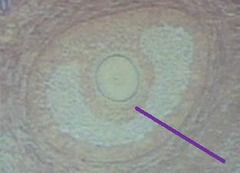
Corona radiata

answer
A thin layer of granulosa cells that surrounds the ovum as it develops in the ovarian follicle and after it is released by ovulation
question
Mature Follicle (Vesicular Follicle; Graafian Follicle)
answer
An ovarian follicle that is fully developed and ready for ovulation The maximum level of estrogen is being produced, and the animal is ready for breeding to take place Next, levels of LH rise In most species, ovulation (rupture of the mature follicle with release of the reproductive cell into the oviduct) occurs In induced ovulators, such as cats, ferrets, and rabbits, breeding must take place before ovulation can occur The oocyte is now called an ovum
question
Corpus Hemorrhagicum (CH)
answer
The blood filled remnant of the ovarian follicle immediately after ovulation
question
Corpus Luteum (CL) ("yellow body")
answer
Forms from the ovarian follicle after ovulation Under stimulation from LH from the anterior pituitary gland, the granulosa cells left in the empty follicle multiply to form the solid CL Produces progestin hormones, principally progesterone, that are necessary for the maintenance of pregnancy If the ovum is not fertilized, the no endocrine signal is sent and the CL degenerates after a short period
question
Follicular atresia
answer
The shrinkage of ovarian follicles that began developing but stopped A normal part of each ovarian cycle
question
Uterus

answer
The womb Where fertilized ovum implants and lives while it grows and develops into a new animal Helps push the fetus out of the birth canal during parturition
question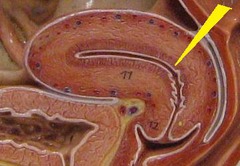
Endometrium

answer
Composed of simple columnar epithelium and simple tubular glands that secrete mucus
question
Myometrium
answer
Made of layers of smooth muscle that give the uterus the strength to push the fetus out during parturition
question
Perimetrium
answer
Outermost layer covered by the visceral layer of peritoneum
question
Metritis
answer
inflammation of the uterus
question
Placenta
answer
A structure that allows an embryo to be nourished with the mother's blood supply
question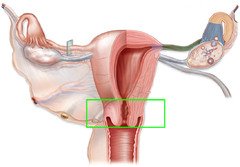
Cervix

answer
The sphincter muscle "valve" between the uterus and vagina
question
Vagina
answer
A muscular, elastic passageway that extends from the uterus to the outside of the body
question
Vulva
answer
external genitalia of the female, Consists of the vestibule, the clitoris, and the labia
question
Vestibule
answer
The entrance into the vulva The short space between the labia and the entrance into the vagina
question
Clitoris
answer
organ of sensitive erectile tissue anterior to the opening of the female urethra
question
Labia
answer
lips of the vagina
question
Estrous Cycle
answer
The period from the beginning of one heat period to the beginning of the next Includes the stages of proestrus, estrus, metestrus, diestrus, and anestrus
question
Proestrus
answer
period of the estrous cycle before sexual receptivity
question
Estrus
answer
Time periods when females are receptive to mating
question
Metestrus
answer
the luteal phase of the reproductive cycle in mammalian females, occurring after ovulation and characterized by development of the corpus luteum, increased progesterone secretion, and decreased estrogen secretion.
question
Diestrus
answer
The active, luteal stage of the estrous cycle During this period, the CL has reached maximum size and is producing maximum amounts of progestin hormones Dogs can have an exaggerated diestrus period, resulting in pseudocyesis, or pseudopregnancy (false pregnancy)
question
Anestrus
answer
The period when the ovary "shuts down" between the estrus cycles or breeding seasons of some animal species
question
Polyestrous
answer
Cycle continuously throughout the year if they are not pregnant Cattle, swine
question
Seasonally Polyestrous
answer
Cycle continuously at certain times of the year and not at all at others Horses, sheep, cats
question
Diestrous
answer
animals with two cycles per year, usually spring and fall (dog)
question
Monoestrous
answer
animals with one cycle per year (fox and mink)



